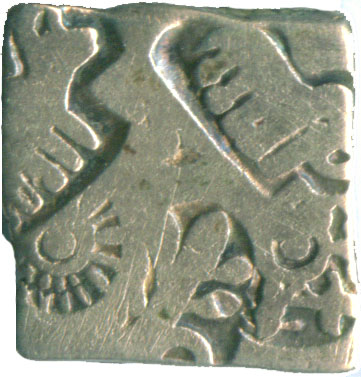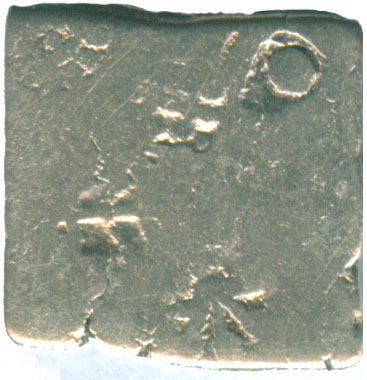| SPECIFICATIONS | |
| Alloy | Silver |
| Type | Struck |
| Height | 15.3 mm |
| Width | 15.4 mm |
| Thickness | 1.7 mm |
| Weight | 3.03 gms |
| Shape | Square |


| Alloy | Silver |
| Type | Cast |
| Height | 17.6 mm |
| Width | 18.7 mm |
| Thickness | 0.8 mm |
| Weight | 1.62 gms |
| Shape | Oblate |


|

|

| ||||||||||||||||
| OBRW G.71; GH #442 | ||||||||||||||||||
|

|

| ||||||||||||||||
| OBRW G.72; GH #442 | ||||||||||||||||||
The lower coin G.72 with just less than half the standard 3.4 gram weight, appears to be cast as apperant from the soft punches. It may have been cast in Lanka based on Struck PMC, like coin G.71 above which has same GH identity and came from same coin hoard.
The Punch-marked coins in a wide variety of shapes, sizes (11-23 mm), thickness (1-3 mm) and weights (1.6-3.4 grams) have been found in Lanka. The obverse is usually covered with Five or Six punch marks, often overlapping. The reverse his has usually fewer punches, frequently smaller and less distinct, often just one or even none.
The identifiable silver Punched-marked coins from Tissamaharama in
Ruhuna belong to the Magadha-Myurya karshapana series.
The best known of the Magadha Empire (BCE 542-413) is King
Bimbisara (BCE 542-493) the Royal patron of the
Buddha Siddhartha Guatama (BCE 563-483) in Pataliputra (Patna).
The best known of the Mauryan Empire (BCE 322-185) is Emperor
Ashoka (BCE 273-232) who sent his son Mahinda to Lanka with the
Buddhist philosophy he conveyed to King Devampiya Tissa
(BCE 247-207) in Mihintale in BCE 247.
This punched-marked coin are cataloged with classification proposed by P. L. Gupta and T. R. Hardaker (1985) in Indian Silver Punched-marked Coins: Magadha-marura Karshapara Series, Nasik, as G&H #442, which is listed as an extremely common type.
Punch-marked coins from a single hoard of 28 Imperial Punched-marked and 4 Lakshmi plaques found in a Terracotta money box (I.1) found in Akurugodella are illustrated in the 1999 catalog Ruhuna. An Ancient Civilization Re-visited by Bopearachchi and Wickramasinhe (OBRW), G.59-G.86 Plates 9-11. These two coin are Plate Specimens G.71 and G72 in this book. Click here for longer discussion and links to other Plate Specimens from this book in this collection.
Text from
* Ceylon Coins and Currency By H. W. Codrington. Colombo 1924
Page 16 Chapter III Ancient Coins - Edlings - Plate 1
The coin was scanned at 600dpi and is displayed at 400dpi.
This coin ex: Raja Wickramasinghe, is from part of Lalith Raddella's
collection I purchased in 2016 December.